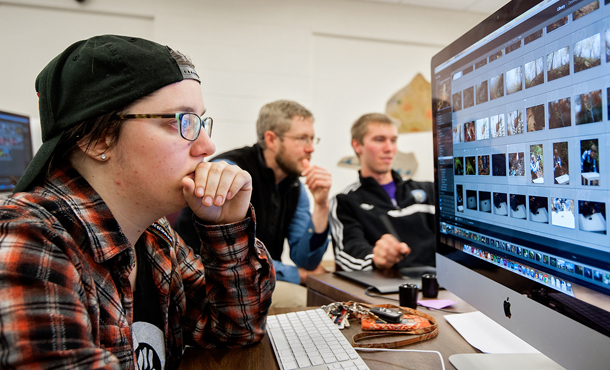After the U.S. Forest Service released its newly revised proposal for George Washington National Forest on Tuesday, many concerns about the forest’s future were laid to rest.
But for Eastern Mennonite University’s conservation photography class, there is still work to be done.
The class, taught by professor Steven Johnson, is in its second year at EMU, and partners students with area nonprofits that focus on environmental issues.
Conservation photography seeks to “think about broader ecosystems, the environment, human culture and how they relate to the natural world,” Johnson, who helped bring the class to EMU, said, “but it’s also about protection.”
The International League of Conservation Photographers helped coin the term when the group started in October 2005.
Each fall semester, the class works with an environmental nonprofit that helps orient students to the region’s natural habitats threatened by development.
Students take photos of the study area, highlighting its ecological relevance and wilderness, for the nonprofit to use for advocacy purposes and advance the cause of conservation.
For the past two semesters, the class has collaborated with the group Friends of Shenandoah Mountain, a coalition of local residents working to protect the “wild heritage of Shenandoah Mountain for future generations,” according to its website.
The main project this semester – and one of the nonprofit’s major goals – aims to shed light on Dominion Resource’s proposed 550-mile pipeline and its potential impact on the region.
“I’m very clear with my students, this is an advocacy class, not a science class,” Johnson said. “We’re trying to contribute to the objectives of these nonprofits we’re working with.”
Lynn Cameron, vice president of the Virginia Wilderness Committee and co-chair of Friends of Shenandoah Mountain, has helped facilitate the students’ field trips to areas near the mountain, such as Braley Pond and the Hankey Mountain area, which would be directly affected by the pipeline, according to the group’s website.
Last year, the class worked with several organizations, such as the Virginia Wilderness Committee, to “establish and advocate for more sections of wilderness” in the George Washington National Forest, Johnson said.
While he admitted that project was “less confrontational” than this year’s, it was difficult to work with multiple nonprofits while managing transportation and logistics. So, this year he focused solely on Friends of Shenandoah Mountain this year because the group was “really invested in our students … and gave them feedback about their imagery.”
Cameron, who’s been active with Friends of Shenandoah Mountain since it formed 10 years ago, appreciates the partnership between the advocacy group and the class, calling it “mutually beneficial.”
“It really helps our efforts to have these images … and being able to show the beauty of the area, the water resources and the recreational resources,” she said.
Students addressed one of the group’s concerns with regard to habitat endangerment when they found and photographed a cow knob salamander on one of their trips, which lives nowhere else in the world, according to Cameron. She was impressed at the engagement students had with the project.
“I was amazed at the way students were so hands-on, looking for life that was there,” she said.
Students also communicated with private landowners whose homes are located close to the proposed pipeline.
“Sometimes, landowners call us and say, `I want people to know this is land that could be taken by the pipeline, and if those images will be helpful in raising awareness and getting people fired up, then I want students to document this area,'” Johnson said.
Courtesy of the Daily News Record, Nov. 22, 2014
